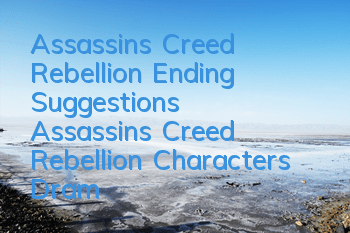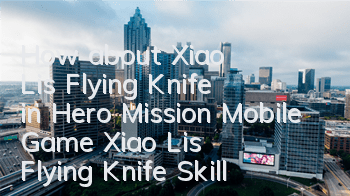I finally got free some time ago and had the honor to play "Assassin's Creed: Rebellion".
To be fair, as a fan of the Assassin's Creed series, my feelings about this work are more of a sigh and helplessness.
The Assassin's Creed series has always been equipped with the assassins' gorgeous skills and a heavy and delicate historical atmosphere. Coupled with the ups and downs of the plot, it creates a magnificent epic stage. It makes people fall into it and it is hard to extricate their feelings.
But after all, the flower is not red. When the Assassin series became a New Year's goods, it changed from an opera that everyone looked forward to to a fixed and updated soap opera. "The Rebellion" is already the 11th work in the Assassin's Creed series. Not to mention that "The Assassin's Creed 2" gives players an extraordinary gaming experience, thus establishing the status of the series in the hearts of players and becoming an insurmountable classic.
As a result, every generation of protagonists in the future was criticized under the shadow of Egeo. Whether it is Connor, who has Indian and British descent, who represents the growth of America, or Edward who traverses the Caribbean Sea to rob the rich and help the poor. They are all roles used by the production team to express the concepts of "freedom" and "anti-authority". According to Assassin's Creed's concept and worldview, it is appropriate to fit in any historical period. However, after experiencing many similar game experiences, players have become aesthetically exhausted. They can even predict that the plot of the Assassin series will inevitably be that a protagonist is bullied by the Templars and his family will be destroyed. Then they defect to the Assassin organization to take revenge while uncovering the Templars' conspiracy. After a few relatives and friends died, they finally killed the Templars' boss. The protagonist unravels his inner conflicts, completes the character arc and grows, and leaves a foreshadowing for subsequent works.
(NPCs who jumped on the tower with the protagonist when the game started to appear are bound to die...)
Fortunately, in "Assassin's Creed 3", the character Shuozai of the Templar Heelsen was "whitewashed" to a certain extent, changing the concept of the temple being purely greedy for power, extravagance, and cruelty in the previous works. The emergence of "The Rebellion" is more of an attempt, putting aside the original routine, allowing players to play the role of the Templar. If "The Rebellion" can reach the sales and influence level of "Assassin 2", it will inevitably lead to the brand series of works of "Temple Creed". The two-dimensional beauty with the Assassin series are the best ending for Ubisoft, investors, and players.
In itself, "The Betrayal" undertakes four main tasks: making profits for the company, continuing the player's emotions, continuously building a brand, continuously improving the game engine, and trying to explore new game themes. But unfortunately, "The Rebellion" is a part of the New Year's goods. As the final chapter of the "Black Flag" trilogy, the production team can only make choices in the game content under the pressure of production time and KPI. The work fails to play to the extreme and has left a lot of room for improvement.
I have said so much and the following is the main text. I willThe focus is on discussing "Bend" from the perspective of emotional engineering and propose improvement plans. Everyone is welcome to communicate.
I subjectively summarized the corresponding problems caused by the inadequacy of "The Rebellion".
This article will first talk about the lack of character characteristics and growth arcs in the game.
The plot of a character is divided into three parts: character contradiction, character preparation, and character arc.
Role Contradiction: The conflict between a character and his inner identity, surrounding environment and other characters is the source of dramatic conflict.
Role preparation: Express a character through character costumes, dialogues, and behaviors. The function is to let players understand the character, generate recognition, and rationalize the character's behavior.
Role Arc: A character's growth process in the game does not refer to the growth of levels, equipment skills, etc., but specifically refers to the character resolving inner contradictions, growing inner into the next stage, becoming a richer character or a completely different character.
Shay Comack, the protagonist of "The Rebellion", is both the details of the Templar costumes and the sentence he often says, "My good luck is in my own hands." Ubisoft has done nothing to lay the role contradictions and character preparation, but what is missing is the deepening of the character arc.
The Eggio in "Assassin 2" can make players so memorable, it is not so much that the rendering power in the plot is so meticulous and well-made. Let players identify with the character Egeo, then follow the character to promote the plot development, experience conflicts, and give different growth experiences to finally complete the character arc.
Eggio's character arc is divided into two lines: one light and one dark, the obvious is that "revenge" trains himself in order to retaliate against the Pochia family, and transforms from a rich second generation into an assassin leader.
——And the deeper character arc is "Search". From looking for enemies when I was young to looking for holy tools when I was young, what runs through it is actually searching for the meaning of life. Therefore, in "Embers", there is the last words of Eggio's reflection. There is no single word that mentions the pleasure of revenge or the promotion of justice, but rather explains that what you are looking for in your life is love.
After experiencing the trilogy, Eggio gradually resolved the contradictions and grew up gradually, from the romantic boy who lingered in the smokey night alley in Venice at the beginning to become a hero's old father. The "sweeping sword" that runs through the entire game - from a tool for personal revenge, to a symbol of practicing the assassin's concept, to harvesting flowers and returning to the family to "turning swords into plows", Eggio completed his growth process. Players also deeply experience the character's growth trajectory through interaction, and finally touched the player and remembered that it was not how many Templars Egeo killed, but how many transformations Egeo had grown throughout his lifetime.
——Growth is the theme of the Assassin's Creed series.
Give an example of a movie other than the game:
The movie "The Last Warrior" also tells a story of rebellion. The protagonist Nathan (Tom Cruise) slaughtered Indian women and children during his service in the US military, and has since been in a state of drunkenness and dreams to escape the trauma of war. By chance, he was hired as a mercenary and trained a new army by the Japanese government. He was then forced to fight with the samurai in advance, fighting hard on the battlefield and was eventually injured and captured.
In the cold winter of the samurai village, he was comforted by his peaceful pastoral family life, and on the other hand, he gradually learned Bushido in his interactions with the samurai leader Katsumoto, resolving the trauma of the past war and regaining the reasons he deserves to fight. The meaning of fighting has changed from "getting wealth" to "protecting what you love".
When the samurai fought with the government army again, he knew that the samurai side had no chance of winning, and in order to penetrate the spirit of the samurai, he still firmly fought against the government army with Katsumoto. As the warriors launched their last charge in front of Green machine guns, Shengyuan committed suicide by defeating the enemy and proclaiming that the warrior era was finally over. The spirit of Bushido infects all the soldiers present, and Nathan becomes the last samurai.
Nathan's character arc shows that it is "rebellion", but in fact it is "healing". He started from a war-traumatized veteran who was treated by Bushido and stood up again and became a samurai who "connects ancient and modern times". Whether as a government hired instructor or a warrior, they are just identities used to show after the inner changes of the role.
After saying so much, go back to Shay's character arc. Shea's character arc is a rebellion, from following the assassin's philosophy to shaking, and then to joining the temple.
But it is a pity that Shay's character arc failed because Shay himself did not grow up during the entire rebellion. The creed of the assassin at the opening is the same person as Shay, who tells the temple philosophy at the end of Versailles. He does not resolve any contradictions or release emotions. Shay just changed her clothes and continued to kill people, continued to sail, and continued to carry out the tasks assigned by her boss. Neither grow into a better assassin nor go to the other extreme to become a Templar.
I am afraid that both the assassin and the temple's concept Shei has a superficial understanding, because in the end he is looking for a powerful organization to rely on and then put his ideas into practice.
Before the launch of "The Rebellion", there were already many speculations about the plot on the Internet, from "Infernal Affairs" to rebellion because of betrayal. I adapted an Infernal Affairs character arc for everyone to discuss:
Modification plan:
Revised the storyPlot:
Set Shay's father was the captain who served the Templars and went to Europe one time to transport the holy artifacts. Shea sneaked into the boat out of her yearning for adventure and longing for her father, but was discovered by the Templar instructor in the boat. The instructor admired Shay's courage and wit very much and asked the captain to let Shay go with him. Unexpectedly, the pirate ship led by the assassin Advale, who had been ambushed for a long time during the voyage. After several fierce battles, the Templar finally retreated the assassin with a holy weapon. However, during the melee, Shay's father was killed by Advale.
This incident greatly stimulated Shay. In addition to planting his hatred for Advale, it also gave birth to gratitude and worship for the Templars, and was fascinated by the powerful power of the holy tools.
The temple mentor took Shea in out of mercy and appreciation and brought him back to England as a preparation member of the temple organization for adoptive son training.
In 1747, the sacred information was discovered again in North America. Given that the Assassin Organization had established a fraternity in North America, the mentor brought 16-year-old Shay back to the Americas to prepare to expand the career of the Templars.
After returning to New York, Shay met his childhood friend Liam at a bar by chance. The two worked together to repel the gangsters in the neighborhood. At this time, Liam had become an assassin. Liam did not know about Shea's past in Europe. He expressed his hope that Shea would join the Assassin organization, and Shea said he would consider it again and again.
After knowing this, the temple tutor explained to Shay that the father-killing enemy Advale was a member of the assassin. Shay's father sacrificed for the noble cause of the Templars. He hoped that Shay would lurk in the Assassin organization as an insider, and promised Nostalgia to let Shay take revenge after breaking the Assassin organization and officially join the Templars. But it also reminds Shei that the killings carried out by the Templars are not for personal grudges but for achieving goals.
In the end, when her father's hatred and friendship were entangled, Shay surrendered to the Assassin's organization. Due to her own emotional factors, Shay always had resistance and doubts about Assassin's Creed, which also led to Shay not being trusted by the Assassin's organization. He was assigned various tasks to test loyalty. Shea wanted to complete the Assassin's mission to gain trust, while on the other hand, he wanted the Templar to convey intelligence.
In the process of completing the missions between the two sides, Shay has a further understanding of the concept of assassin and the temple. Especially after getting in touch with his enemy Advale, he learned from him that what the assassin did was also to bring peace and happiness to the world. He began to reflect on the ideas and positions of both the Temple and the Assassin, but this also gradually made him fall into deeper contradictions.
The last test mission given to Shay was to participate in the assassination of the Temple Tutor.
Shay asked the instructor to escape overnight after learning the mission. After thinking about it, the instructor calmly gave Shay the temple ring on his hand, saying that he would return to Europe, and the new temple tutor Helsen is about to arrive.
In order to ensure Shay's identity is safe, he did not mention anything about Shay's lurking to anyone, even to come to the scene.Heelson had no idea. Let Shay choose the right time to return to the temple with the ring. At the same time, she repeatedly ordered Shei to act according to the assassin's plan, avoid exposing her identity, and make other arrangements for the assassination.
But on the day of assassination, the mentor did not flee back to Europe. Instead, he calmly made an appointment, killed several assassins alone and deliberately died under Xie Yi's sword. Let Shay gain the trust and favor of the assassins, and use curses to make Shay remember the temple's concept - killing is not for personal hatred.
Shay successfully assassinated the Temple Tutor, gained the trust of the Assassin Organization and officially became a member of the Assassin and was entrusted with important responsibilities, and his status quickly rose. But what followed was the jealousy and exclusion of Shay by others such as Virondri, and in the later expansion of the gang force mission, Shay felt more and more that the dark side of the Assassin's organization was getting farther away from Assassin's Creed.
After the mentor's death, Shay lost the protection of the Templars and could only continue to exist as an assassin. In the end, during the mission in Lisbon, he felt deeply guilty for failing to prevent the occurrence of a major earthquake. He stole the pioneer manuscript without contacting the Templar, but was hit by the assassin organization to ambush the original game plot. After being rescued by the Templars, Shay also confirmed his identity with Helson through the ring and officially joined the Templars.
The revenge of killing his father and the guilt of serving assassins became the driving force for the Sheai Hunting Assassins organization. Finally, the Assassin Brotherhood's stronghold in North America was cleared, the Templars' power network was established, and the rest of his life was devoted to the pursuit of the "Box of the Path" and finally regained the Box of the Path in Versailles in France in 1776.
But the 45-year-old has also seen through his personal desires hidden under the great ideas of both sides over the years, believing that the Templar's biggest enemy is not the assassin, but his own possessiveness of power and power. The ancient holy artifacts are the greatest temptation to human nature. Civilians and assassins cannot face such temptation, and can the Templars still stick to their beliefs in the face of temptation?
Shay, who was already a temple tutor, finally chose to retire. After Helson died at Connor's hands, the North American Temple Branch asked Shea to return to take over as the Grand Commander. Shay refused the invitation and chose to put down the temple ring and sneak sword at Helson's funeral as a burial. Since it means that Helson's lifelong entanglement with the temple and the assassin, he also means that he let go of all his grudges.
Revised the theme of the story: Reflection on "power" and personal "desire".
Revised storyline:
Determine the bright line of the story as Shay "abandoning the dark and turning to the light" from an assassin to a Templar.
The dark thread is "let go", and Shay goes from his desire for "power" to getting rid of "desire". "Strength" not only includes stronger warships, more clever assassination methods, but also refers to the power in the weaving. Echoing Lieutenant General of Assassin 3 Tyrant WashingtonGolden Apples have been thrown into the Atlantic Ocean, leaving power and desire to silence.
Essentially, Shay betrayed the two organizations at the same time. First, he realized that the Assassin organization was corrupted by personal desires and violated its own creed, so Shay rebelled and wiped out the North American Brotherhood. However, in the mission of the Templars, he gradually discovered that the Templars could not escape the rules, so he chose to retreat and no longer rely on the "power" provided by the organization to free himself.
Revise role definition:
The young Shea lives in a difficult environment with her father, so Shea is eager to have the strength to help her father develop his career. His father's death made him feel guilty about his incompetence and stimulated his desire for power. At the same time, he also longs to be protected by powerful forces, so he follows the Templars.
Through the lives of the two organizations of Assassin and Temple, Shay gradually possesses strength while also reflecting on how to use the strength reasonably. When both organizations lose control of their power, Shay no longer pursues being protected by the organization's power, but chooses to let go of his power.
The maps of assassins of all generations represent freedom "eagles", while Shay should be "wolf". In addition to the wolf that appears in the original game's opening and ending animation, as well as the bow image of the Morrigan ship and the wolf head pattern on the dark red sail. More importantly, Shay's own behavior is to hunt wolves. He was driven by assassins in the first half of his life and hunted assassins in the second half of his body.
Contradictions and conflicts are divided into three layers:
Shay himself hatred with the assassin (The conflict between the individual and the environment was established through the murder of his father and the martyrdom of the mentor. It was untied by the murder of Advalai and the assassins)
The opposition between the Templar and the Assassin Organization (Conflicts outside the environment, setting of the story background. The North American Assassin Brotherhood was destroyed and untied)
Own desire for power (Personal growth contradictions and role positioning settings start from having no strength to protect his father, to Shay's years of thinking about the holy artifact, and finally put down the ring and the sleeve sword and untie it)
Shay's character arc is also divided into 5 stages, triggering the character's action in each stage.
Payoff settings:
Xianjian:
Symbols of hatred
The father was killed by Advalai with his sword. Shay was impressed by the sword and mapped the revenge of killing his father to all the assassins wearing the sword. In the end, Shay also killed Advale with his sleeve sword, and hatred was vented, which arose and ended.
Symbols of Assassin's Creed
Shay brought her back with her sword after joining the Assassin's organization, which was to show the assassin's recognition of Shea. It not only means that Shay successfully obtained the identity of an assassin, but also means that his hands that practiced his will were imprisoned. The Shunjian is an embodiment of the will of the Assassin Organization. Shay used the Shunjian to assassin the Temple Tutor and became a tool for the Assassin Organization to achieve its goals.
Symbol of Power
By obtaining the sword to learn combat skills, Shay gained the power of revenge. The sleeve sword is reflected as a life-taking force, but this force is not controlled by Shay, but belongs to the assassin organization, and Shay is just a tool for practical power.
When he became the Templar and hunted assassin with his sleeve sword, it means that Shay is no longer a tool of power. Instead, the Templar, who can control the power in turn, finally put down the sword at Helson's funeral, which means letting go of this kind of power.
Temple Ring:
Guardian's Symbol:
Shay first saw the ring carried by the temple tutor on the ship, and the tutor fought against the Assassin's organization. Therefore, the temple is defined as the Guardian. Shay joins the Templar and wears a ring as well as performing the Guardian's duties and extinguishing the riots caused by the assassins.
Symbols of the Templar Concept:
The ring serves as the carrier of the will of the Templar. The temple mentor gave Shay the funeral arrangements to Shay. This was the final guide for Shay, so that she could remember the temple philosophy and also recognized Shay as the Templar.
Shay held the ring tightly in her hand with her waist sword, indicating that she was assassin on the outside but also the Templars on her heart. It is the use of assassin's methods to practice the Templar's philosophy.
Helson held a ceremony for Shay, formally putting on a ring to indicate that the "rebellion" was completed, Shay's identity became the Templar.
Symbol of Power
The ring is also used as a stamp in Europe, and it has the meaning of power. After Shay became the Templar, he could mobilize the forces in the colony to hunt assassins, and the ring was a manifestation of power. Finally, putting down the ring at Helson's funeral means putting down this pursuit of power.
After talking about the shortcomings of characters in the game and the personal suggestions for modifying characters, the next article will talk about the assassin's "rebellion". The revision suggestions are only a whim. Everyone is welcome to share your views on the Assassin series, or talk about the masterpieces in your heart.









